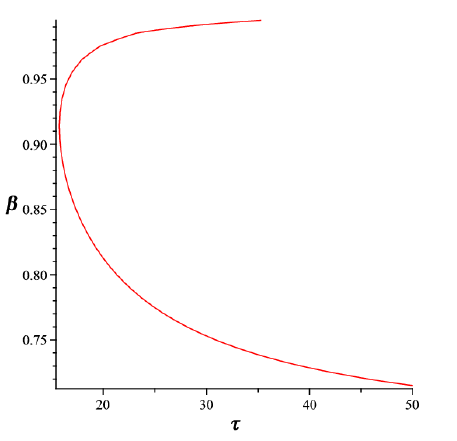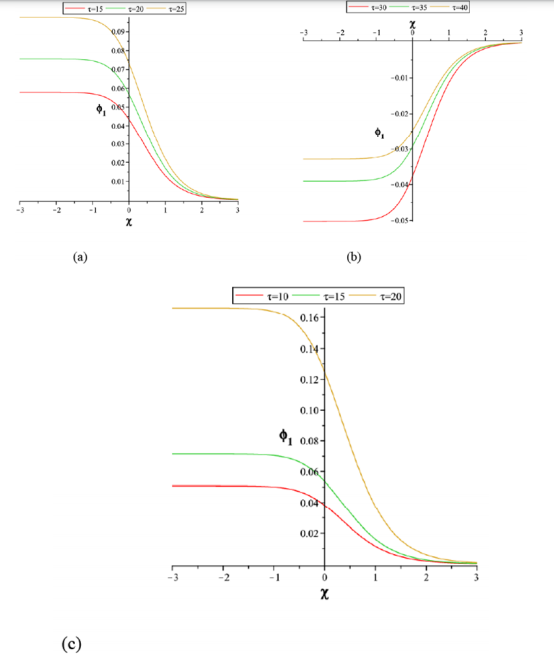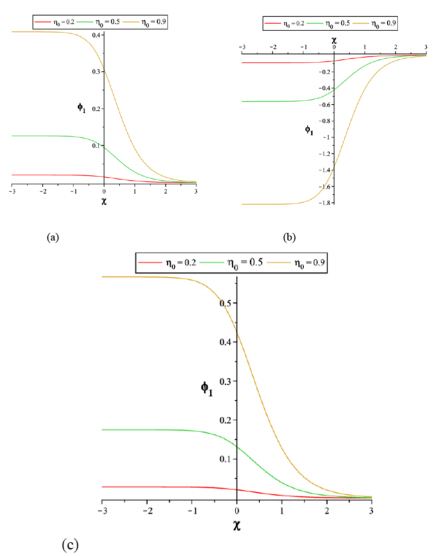One the most important subjects in the plasma physics is the propagation of nonlinear waves that can be described by different partial differential equations as Korteweg-de Vries (K-dV) equation,1 Korteweg-de-Vries Burger (K-dVB) equation2 and the nonlinear Schrödinger equation (NLSE).3 Electrostatic solitary waves (solitons) that described usually by K-dV equation derived by balancing the nonlinearity of the medium with the wave dispersion. On the other hand, for a dissipative media, the balance between nonlinearity and dissipation may lead to formation of the shock structure. Shock waves in plasmas are different from these in normal gases. Because of presence of charge particles, certain types of shock waves can exist in a plasma. Shock waves can also be observed in space4–6 and experimental7–9 plasmas. Plasma with two-distinct group of electrons (cold and hot) can also be seen in space plasmas.10,11 Many papers have investigated the propagation of ion-acoustic solitons in a plasma with two types electrons.12–14 In such as media the theoretical and experimental results have been shown that the characteristics of solitary waves strongly modified by the presence of minority population of cold electrons.15–17
However, in the space and astrophysical plasma environments such as solar wind, magnetosphere and auroral zone plasmas, particles are often characterized by velocity distributions that are not Maxwellian and modeled by a kappa (or generalized Lorentzian) distribution function.18–20 Recently, the propagation of ion acoustic solitons in collisionless plasmas with high-energy particles (represented by kappa distribution) is investigated in many papers.21–27 In addition, the existence and propagation of ion acoustic solitons in a plasma with two-temperature kappa distributed electrons have been investigated in.28–30 They have been studied treatment of small and arbitrary solitary waves by deriving an energy integral equation. On the other hand, it should be remarked that a medium with dispersive and significant dissipative properties supports another solitary wave such as shock waves instead of solitons. Many researchers have studied shock wave structures in superthermal plasmas. For example, Sultana et al.31 have studied dynamic of shock waves in a collisionless electron-ion plasma with superthermal electrons which is modeled by kappa distribution function. They obtained that higher deviations from a pure Maxwellian behavior induced shocks which were larger, narrower and faster.31 Ion-acoustic shock waves in a plasma consisting of electrons, positrons and ions with Boltzmann distributed positrons and superthermal electrons were also studied by Pakzad.32
It is observed that an increasing positron concentration decreases the amplitude of the waves. The characteristics of ion-acoustic shock waves in electron-positron-ion plasma were investigated in33 where electrons and positrons were modeled by kappa distribution function. It is seen that the amplitude of ion-acoustic shock waves decreases as the positron density and electron temperature increases.33 In addition, Shah et al.34 have investigated the effect of positron beam on the ion-acoustic shock wave in a plasma consisting of inertial ions and superthermal electrons and the positron beam. They have derived the spectral index of the superthermal electrons, and concentration of impinging positron beam have significant effects on both the amplitude and steepness of the ion-acoustic shock wave. The oblique propagation of ion-acoustic solitons in magnetized plasmas containing kappa distributed hot and cold electrons have examined by several authors.35,36 In addition, Bains et al.37 studied the propagation of ion-acoustic shock waves in a magnetized plasma consisting of cold ions and two different temperature kappa distributed electrons. It is seen that all plasma parameters such as the density of hot electrons, the superthermality of electrons, the obliqueness, the strength of external magnetic field and the ion kinematic viscosity increase the shock height. The investigation of dust ion acoustic shock waves in two temperature plasmas has attracted significant attention among researchers.38–40 However, the properties of shock waves in a plasma containing cold ions, cold (Maxwellian) and hot (superthermal) electrons has not been reported so far in papers. Therefore, in this paper using reductive perturbation technique, we have investigated shock structures from the solutions of the K-dV Burgers equation. Both the cases with quasi-neutrality condition as well as Poisson’s equation have been considered to observe such type of structures. It has been noticed that with the presence of the dissipation terms, a significant variation of the structures is observed. The layout of this paper is as follows: in section 2, we present basic equations and obtain K-dVB and Burgers equations. Also, these equations are solved by tanh method. Numerical results are given in Sec. 3. Finally, in Sec. 4 the conclusions of the present work are discussed.
We consider one nonlinear three -component homogeneous plasma consisting of cold fluid ions, cold and hot (superthermal) electrons. Here, it is assumed that cold and hot electrons have Maxwellian and kappa distribution functions, respectively. In equilibrium, the quasi-neutrality condition is as
where
,
and
are theunperturbed number densities of the cold electrons, hot electrons and ions, respectively. It is assumed that the present medium has dissipative properties in addition to what mentioned earlier. The fluid model for the ions is described by the following continuity and momentum equations:
(1)
(2)
The system is closed by Poisson’s equation:
(3)
In the above equation nc, nh and ni are the density of cold electrons, hot electrons and ions, respectively. is the velocity of ions; and is the electrostatic potential. An ad hoc damping term is introduced in the momentum equation, involving the (ion) kinematic viscositye is the magnitude of the electron charge and is the ion mass. In our analysis, all parameters are normalized as follows, the ion and cold (hot) electron densities by the unperturbed ion density nio the ion velocity by
the electrostatic potential by
the space and time are normalized by Debye length
and ion plasma frequency
respectively. Therefore, the basic normalized equations in this system can be written as:
(4)
(5)
(6)
Where the normalized (ion) kinematic viscosity variable is defined as
The normalized number densities of electrons are given by
(7)
Where
and
where Tc and Th are the temperature of cold and hot electrons, respectively and the variable
is defined as hot to cold electron temperature ratio, namely
The effective temperature Te given as
(8)
Here k is the spectral index that measuring deviation from Maxwellian equilibrium and valid for
Ion-Acoustic shock waves
We are now interested for investigation propagation of shock waves in present plasma model. Therefore, we shall employ reductive perturbation technique.41 The independent variables can be stretched as
and
(9)
Where
is a small parameter and
is the unknown linear phase velocity to be determined later. Also, the independent variables, and can expanded as follow
(10)
In continue, substituting equations (9) and (10) into equations (4)– (6), and isolating distinct orders in
we obtain a Korteweg-de Vries Burgers (K-dVB) type equation in the form
(11)
Where
(12)
Where
(13)
Here
where
is the finite quantity of the order of unitary. On the other hand, if we assume the quasi-neutrality condition by employing the reductive perturbation method and using equations (4) -(5) and the Poisson's equation in form
(14)
one can drive the Burgers equation as follow:
(15)
Finally, we will obtain exact solution for ion acoustic shock waves in current plasma model by tanh method.42,43 For K-dVB equation (11) a monotonic, kink-like shaped, solution is obtained via using this method in the form:
(16)
Where we have performed a transformation of the coordinates
here
and
are related to the inverse width and the speed of the shock, respectively.42,43
In which for Burger equation (15) we have
(17)
where the amplitude
and the widthare given by
and
(18)
(Here
and
is a velocity [42-43].
In this study, a rigorous theoretical investigation of electrostatic shock structures in two electron temperature plasma (having cold and superthermal electron) with cold ions are carried out. By employing reductive perturbation method, K-dV Burgers equation is derived. It is found that the coefficients of the K-dVB equation are significantly modified by ratio of unperturbed density of hot electron to ion
hot to cold electrontemperature ratio
and superthermality parameter k. By assuming quasineutrality, Burgers equation is also derived and its details will be investigated in the following.
It should be noted that the nonlinear coefficienthave negative, zero and positive values. Therefore, it is observed that shock potential profiles are positive (negative) if
On the other hand, the vanishing of the nonlinear coefficient in Eqs. (11) and (15) (i.e., when) determines the critical values of
In continue, to find the parametric regimes for the existence of opposite polarity shock potential profiles, we have numerically analyzed the nonlinear A termand obtain
curve in Figure 1. From this figure, it is clear that for the fixed values of
and k=3 we have two critical values 0.812 and 0.976, where for densities lie in two ranges
and
the nonlinear coefficient is positive and we havecompressive shock waves, while the densities lie between these two critical values, namely
lead to the rarefactive shock waves.

Figure 1 The showing variations of the nonlinear coefficient A = 0, the number density
versus temperature
for k = 3.
Potential profiles of the ion acoustic shock waves, as given by Eq. (16), for fixed values
and different cases of density
are investigated in Figure 2. It is observed that the amplitude of positive shock waves increases (decreases) with
for case
(see Figure 2(a) and 2(c), respectively) in which for
(rarefactive shock waves) the amplitude decreases by increasing the hot electron density see Figure 2(b). It should be remarked that our results are different from results given in.36 They studied the influence of hot electron density population on shock waves and shown that there is only a critical value≈ 0.58 and in the both cases (compressive and rarefactive shock waves) the amplitude of shock increases with increase in the hot electron density.37

Figure 2 Variation of
with
- Eq. (16) - for different values of
with k=3,
=20, and
=0.3 for (a) 0 <
<
(=0.812), (b)
<
<
and (c)
>
(=0.976).
The hot to cold electron temperature ratio is examined in Figure 3. It is shown that for a fixed value of density
(where it is assumed lower than first critical density
the amplitude of the shock waves increases as increases (see Figure 3(a)), while form Figure 3(b) it is found that for case
(between two critical value) by increasing hot electron temperature, the amplitude of shock waves decreases. Finally, from Figure 3(c), it is clear that for case
(bigger than second critical density
the amplitude increases as
increases. This means with increase temperature the plasma model can support larger (smaller) compressive (rarefactive) shocks. On the other hand, withcomparing Figure 3(a) and 3(c), it is seen that the intensity of compressive shocks is significant when the plasma model satisfies higher density of hot electron. These results are important and don’t see in.37

Figure 3 Variation of
with
- Eq. (16) - for different values
with k = 3 and
= 0.3for (a)
= 0.7 (b)
=0.85 and (c)
=0.985.
It is clear that if dissipative effects (due to the kinematic viscosity) in a plasma medium become very strong the shock waves will appear instead solitons. Therefore, to complete discussion, the effect of kinematic viscosity is shown in Figure 4 for different density cases
respectively. It is observed that ion kinematic viscosity increases the amplitude both compressive and rarefactive shock waves. On the other hand, it is shown that shock strength increases as the viscosity in the system is increased. It is also clear that transformation from solitons profile to shock structure occur in large values
The results are similar to that obtained in37 for an oblique propagation of shock wave in a superthermal magnetized plasma.

Figure 4 Variation of
with
- Eq. (16) - for different values of
with k = 3 and
=20 for (a)
=0.6, (b)
=0.85 and (c)
=0.995.
In continue characteristics of the Burgers shock waves -described by Eq. (17) – is investigated. In Table 1, we give values of the amplitude
and width
shock waves for various values of density
. It is seen that the amplitude of the compressive shock waves increases (decreases) as the density is lower (larger) than
while the amplitude of the rarefactive shocks decreases by increasing density. In addition, it is interesting to note that the width of the shock waves seems to decreases with density
for all cases of density.
The different cases for density |
|
|
|
|
0.65 |
0.023 |
30.68 |
|
0.75 |
0.053 |
29.41 |
|
0.80 |
0.256 |
28.46 |
|
0.85 |
-0.084 |
27.12 |
|
0.90 |
-0.039 |
25.14 |
|
0.93 |
-0.035 |
23.39 |
|
0.98 |
0.185 |
18.63 |
|
0.985 |
0.069 |
17.94 |
|
0.995 |
0.026 |
16.38 |
Table 1 The variations of the amplitude
and width
shock waves – described by Burgers equation- for fixed values
and the various values of
The influence of hot electron temperature
on the amplitude
and width
shockwaves – described by Burgers equation (17) – is examined in Table 2. This table show that as the hot to cold electron temperature ratio increases the amplitude of compressive shock waves increases. However, for the rare active shock, the amplitude of a shock decreases with increase in Also, it is clearly depicted that the considered plasma model support wider shocks as hot electron temperature increases. We have also investigated the effect of the kinematic viscosity on shock waves propagation in such plasma in Table 3. It is found that an increase in
(meaning an increase in dissipation) considerably caused an increase in the amplitude both compressive and rarefactive shocks. On the other hand, it is found that shock strength increases as the viscosity in the system is increased. In addition, we see from Table 3, that shock waves have low width and propagated narrower for large kinematic viscosity coefficient.
The different cases for density |
|
|
|
|
15 |
0.024 |
29.3 |
|
20 |
0.031 |
30.13 |
|
25 |
0.04 |
30.67 |
|
30 |
-0.02 |
28.66 |
|
35 |
-0.016 |
29.17 |
|
40 |
-0.013 |
29.58 |
|
10 |
0.021 |
16.8 |
|
15 |
0.029 |
17.39 |
|
20 |
0.069 |
17.94 |
Table 2 The variations of the amplitude
and width
shock waves – described by Burgers equation- for fixed values
and the different values of
The different cases for density |
|
|
|
|
0.2 |
0.008 |
46.7 |
|
0.5 |
0.052 |
18.68 |
|
0.9 |
0.17 |
10.37 |
|
0.2 |
-0.037 |
40.69 |
|
0.5 |
-0.233 |
16.27 |
|
0.9 |
-0.757 |
9.04 |
|
0.2 |
0.011 |
24.57 |
|
0.5 |
0.072 |
9.82 |
|
0.9 |
0.236 |
5.46 |
Table 3 The variations of the amplitude
and width
shock waves – described by Burgers equation- for fixed values
and the different values of






